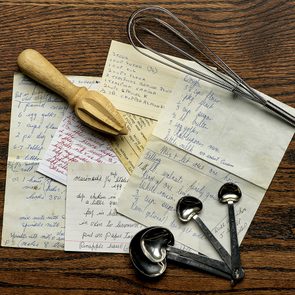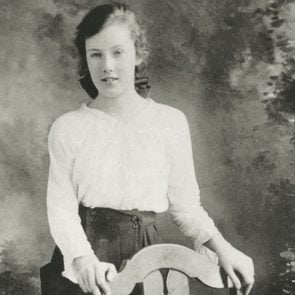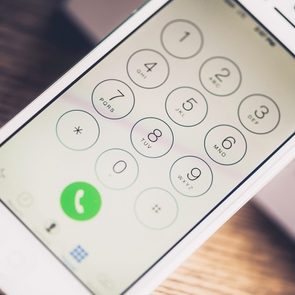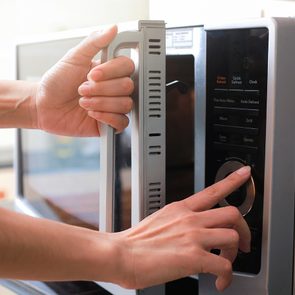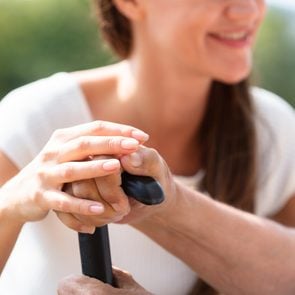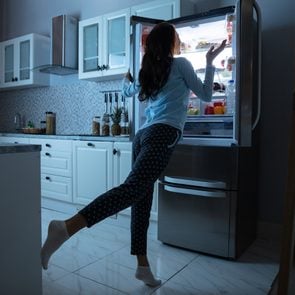
Around our broad brown table, we often sit and talk after eating a hearty meal or a social snack. It is an old-fashioned solid oak table with a hole for the crank at one end to open and lengthen it by inserting two more planks. The only time we took the boards out was when we moved, and it needed to be made as light as possible.
Whenever I put on a fresh tablecloth from our travels in Mexico or the Philippines, it looks quite elegant, especially if set with crystal goblets and carefully placed silver cutlery.
I sit in my usual spot, with teapot in hand, ready to pour tea or coffee. As I do so, I can’t help but wonder, where are the dear folks who have shared food and time with us around this familiar table?
Joyful Times
What I like to remember are the schoolchildren trooping down the lane, eager to come for an after-school birthday party. We always invited the whole class and most of them came for games in the yard and cake at the table. A few days ahead of the birthday, I would write our child’s invitation to hand to the teacher. She would read it to the class, and they would accept the oral invitation because we all knew each other in the Mt. Lehman, B.C., community. Gifts were not expected and seldom exchanged. After the party, or during games, a parent would often come to help and pick up some of the children, or else I would bring home the ones from farther away.
Similarly about once a year, the Sunday school classes that we or our grown children taught would come over for lunch after the Sunday morning service. It was surprising how many youngsters would fit on each side and at least three on each end of the broad table. After a hearty meal, the hayloft appealed to some adventure seekers.
The hungriest group, however, were the young fellows who came to haul in the rectangular hay bales. For them it was roast beef, potatoes, corn and pies. They didn’t notice the plastic tablecloth over the hardwood table, but eagerly dug into the home-cooked meal.
Because our dairy herd was on test for genetic production records, a licensed tester came every month. Art Maddocks shared a monthly breakfast with us for many years. He faithfully sat and listened to our regular pre-breakfast devotional ritual and prayer.
As the children grew up, mealtimes changed. The table seemed rather large when I got up extra early to have breakfast and a few words with our eldest teenager who worked an early shift. He would hastily eat his cereal before rushing off with a thermos and a shiny steel lunch kit. A few years later, our daughter in her smart white uniform ate little before heading to work at the nursing home. During the college and university years, we often hosted young people on choir tours or basketball team members passing through.

for guests.
Warm Welcome
At our annual family Christmas dinners, the antique wooden table remains central. As the family grew to 27 and beyond, however, we added another folding table to make room for everybody. We take turns reading a verse until the whole Christmas story is told but the minute after Grandpa’s “Amen” is spoken, happy chatter and teasing fills the air.
The crank for the table is seldom used to shrink it in size. We prefer to keep it extended so that there is always room around the old oak table for a few friends, or even a crowd.
Next, take a look back at the all-important role of the kitchen stove during the 1930s.
We’ve all had it happen: You look at your phone and notice a missed call from a familiar-looking number that isn’t in your contacts. Your first instinct might be to call back and see who it was, but that’s the last thing you should do.
You might assume calling back is safe because a number happens to be from your area code. Is it your doctor? Your kid’s principal? A neighbour? Unfortunately, the answer is probably none of those, says Adam Levin, founder of CyberScout and author of Swiped: How to Protect Yourself in a World of Scammers, Phishers, and Identity Thieves. Scammers “are adept at spoofing phone numbers for caller ID purposes,” he says. So just because a number shares your area code doesn’t mean the caller is from your town. Crooks purposely use familiar area codes to gain your trust.
You’d probably ignore a number with a different area code, but a number that comes from your hometown seems more likely to be someone you know. “People are curious and they’re counting on that,” says Levin. “It’s the concept that people think may have missed an important call.”
At the very least, answering the phone or calling back makes you vulnerable to future scams, says Eva Velasquez, CEO and president of Identity Theft Resource Center. “When you call back not only are you verifying the number is attached to a real person but that you’re willing to make the effort in calling back an unknown number,” she says. “This puts you at risk for scammers to call you at a different time and try to scam you with another ploy.”
And at worst? For one thing, scammers could convince you to give out personal information, like your credit card number. Even if you don’t give out personal information to the other line, though, that call could cost you major money. The numbers are sometimes hooked up to sex lines that charge by the minute—and it adds up fast, says Levin. “You’re paying $17 and change for the first minute, and $9 and change for every minute after that,” he says. (Beware of these common online scams.)
In general, you’re better off ignoring an unknown number and forgetting about it, says Velasquez. “Any important news will be left in your voicemail,” she says.
Be careful even if the person does leave a message, though. Just like scammers can pose as a credit card company when you answer, they can leave an important-sounding voicemail, too. So if your bank leaves a voicemail, don’t just call back the number from the missed call. Find the official number online and dial that, suggests Levin. “Never trust—always verify,” he says.
Keep reading: If you ever hear this four-word phrase when you answer the phone, hang up immediately.
When your sweet tooth is calling, there’s no better way to answer it than with some fudge. Rich, decadent and creamy, fudge is a guaranteed hit no matter the occasion. But you don’t have to head out to a specialty candy shop or spend half a day making homemade fudge to satisfy your craving. We’ll show you a microwave fudge recipe that’s so easy, you can throw it together on a weeknight.
The Best Microwave Fudge Recipe
When it comes to ease, microwave fudge is the way to go. Not only does it take less time than an old-school fudge (seriously, this microwave fudge recipe takes less than five minutes to make!) but it’s also great for those who don’t have a ton of candy-making experience.
Traditionally, fudge needs to be boiled, brought to the soft-ball stage, cooled and beaten, and it requires special tools like a candy thermometer. This microwave fudge recipe, however, only needs a bowl, spatula and 9×9 pan. How simple is that?
Our incredibly easy microwave fudge recipe comes from Taste of Home reader Sue Tucker of South Carolina. Sue says, “You’re moments away from a pan of creamy fudge. Just microwave, stir and spread. This easy homemade fudge recipe is the best.” And we can’t help but agree!
Ingredients
- 1-½ teaspoons plus 1 tablespoon butter, divided
- 2 cups semisweet chocolate chips
- 1 package (11-½ ounces) milk chocolate chips
- 1 can (14 ounces) sweetened condensed milk
- 1 teaspoon vanilla extract
Yield: About 81 pieces
Tools
- 9-in. square pan
- Foil
- Bowl
- Spoon or silicone spatula
Directions
Step 1: Prepare the Pan
Before you begin, line a 9×9 square pan with foil. Then spread about 1-½ teaspoons of butter over the foil, paying special attention to the corners. This will make the fudge much easier to remove once it has set.
Step 2: Melt the Chocolate
To a large, microwave-safe bowl, add the remaining butter and chocolate chips, then microwave for one minute. Remove the bowl and give the butter and chocolate a good mix. Continue to microwave and stir the mixture in 30-second intervals until the chocolate chips have completely melted.
Step 3: Add Remaining Ingredients
While the melted chocolate is still hot, stir in the sweetened condensed milk and vanilla extract, and mix until they’re fully incorporated.
Step 4: Transfer and Cool
Spread the fudge in your prepared pan and place it in your refrigerator until the fudge is firm.
Test Kitchen Tip: If you’d like to add any toppings to your fudge, like chopped nuts, do so before putting it in the fridge.
Step 5: Slice and Serve
Once the fudge has set, use the foil lining to lift it out of the pan. Cut the fudge into bite-sized pieces and treat your sweet tooth!
How to Store Microwave Fudge
If you have leftover fudge, place it in an airtight container and store it in the fridge for up to three weeks.
How to Customize Your Microwave Fudge
Once you’ve mastered microwave fudge, make it your own. Here are some of our favourite fudge toppings:
- Chopped peanuts, almonds or walnuts
- Crushed cookies or chocolate bars
- Sprinkles
- Peanut butter or marshmallow fluff swirl
- Dried fruit
- Glazed bacon
- Almond or orange extract
- Espresso
Common Microwave Fudge Questions
How Do You Fix Microwave Fudge?
If your microwave fudge didn’t turn out how you’d expect, there are a couple of things that could be responsible.
The first would be that the chocolate was overcooked by the microwave. Since microwave power varies from unit to unit, a minute and a half of zapping could be too powerful and turn your chocolate grainy. To revive it, add a tablespoon more butter or additional chocolate chips and stir. This should return the mixture to a smooth, creamy texture.
If your chocolate was burnt in the microwave, however, it’s best to toss the chocolate and start over.
Another issue could be that sweetened condensed milk was swapped for regular milk or a milk alternative, resulting in a runny fudge. Sweetened condensed milk is milk that has had its excess water removed and sugar added, resulting in a thick, glue-like texture. This thickness is important to this microwave fudge recipe as it helps solidify and stable the fudge. The best way to avoid this mistake is to stick to sweetened condensed milk, or use evaporated milk and add your own sweetener.
What Can I Do With Fudge That Won’t Set?
If you used the correct ingredients and method but your fudge still didn’t set up, don’t toss it! Instead, use it to top a bowl of ice cream or spread it between cake layers for a fudgy filling. Or you can eat it with a spoon, we won’t judge.
Next, check out this tasty, time-saving microwave banana bread recipe.

IN THE WINTER OF 2016, we were walking in a long, deviating oval around Trout Lake, on the east side of Vancouver, and Kenny said, “I think there’s something wrong with Omma.” He sped up.
“Wrong how?” I hurried to keep pace.
We’d been together for four years at that point. He chewed his lip and squinted down at our dog padding between us. It was a gorgeous day, and there were dogs everywhere, chasing, yawping.
“Did she say something?” I asked.
“No. But you know how she’s been calling. A lot.”
I did know. Sometimes we woke to a dozen missed calls from Kenny’s 68-year-old mom. The week before, they’d made lunch plans, confirmed the location twice, and she still wound up waiting at the wrong restaurant. This lost quality of hers had been coming on so slowly, though, that it seemed halfway natural. Then again, my take didn’t count for much because, to me, Kenny’s mom was always a little obscured by a language barrier—her English was rudimentary and my Korean non-existent.
“Well, what are we talking about?” I asked Kenny as we turned off the path, onto the lakeshore. “Do you mean something mental? Like you think she’s got dementia?”
It was so easy, then, to throw out words like that. They had no reality to them; they referred to an imaginary crisis you read about in newspapers, saying, “Just awful; must be hell”—something that dragged down a group of poor others.
Broaching the subject that day seemed to unleash her symptoms, like an incantation or a jinx. Soon, confusion and paranoia broke through the surface of her calm, cheerful demeanour, and it became impossible to deny that something had fallen apart in her mind. Omma began complaining about a woman who lived in the bathroom mirror and emerged to steal her things. To thwart this thief, she would hide her favourite clothes in stashes around the apartment. She then forgot where she’d hidden them, or that she’d hidden them at all, and so her original delusion became a self-fulfilling prophecy—the woman in the mirror, who was herself, was indeed stealing her things.
Kenny’s father, then 70 years old, took an old shower curtain and duct-taped it over the mirror. But this only bounced the confusion from one pane of glass to others: soon Omma’s computer and phone became portals for her fantasies. She watched YouTube videos of Korean pop stars like Patti Kim and Moon Ju-Ran, insisting the celebrities were her intimate friends. She carried on conversations with the singers through the glass. When Kenny came to visit, she would sit him down and introduce her son to these famous friends, all of whom agreed: Omma had a beautiful singing voice. In fact, she would sing for them when they asked, conjuring hundreds of audience members in her two-bedroom apartment. The audience would disappear just as Kenny arrived.
We moved Omma and Appa into a retirement home where meals and laundry services were provided, but we soon realized Omma wasn’t getting the care she required. The new apartment had a small kitchen and bedroom, a living room with a TV, all the makings of a miniature home, and placing them there allowed us to fool ourselves a little longer into believing that a life, a mind, was not disassembling before us. I still had in my head a simple idea of dementia, where Omma would sit quietly at a window, perhaps work on a puzzle or flip contentedly through a picture book. I kept saying we should buy Time-Life volumes from the 1960s and ’70s, books full of images that might jog her memory.
ACCORDING TO Alzheimer’s researchers, someone on the planet develops dementia every three seconds. But what can that possibly mean? Dementia is not a lamp switching off. It is the evening sun, moving by degrees so imperceptible we cannot say when things are halfway gone or when they have disappeared altogether. It darkens, eats at, the corners of experience, first seeming like a trick of our perceptions but proceeding inexorably until at last we find ourselves swept past the warning stage and mired in the irrefutable night. And yet there must have been some three-second period, I suppose, when one could say, “Now she has lost herself. Now we have lost her.”
Kenny and I have parents at the oldest edge of the Baby Boom, which means we are harbingers of a sort. Our experience is common enough already, but caring for a parent with dementia is about to define my generation. Such care will explode in our lifetimes, will dominate our attention, bank accounts and—most painfully—our consciences. Only climate change—another reckoning with our ability to care—will rival it.
As Omma’s illness became obvious, she joined 55 million other dementia sufferers around the globe. That number is expected to rise to 139 million by 2050. (The global senior-citizen population is, itself, ballooning.) The global cost of caring for all those dementia patients will grow to more than $2 trillion by 2030.
Of course, even those trillions of dollars are only a mitigation, a fractional help. The lived reality is still chaos, still heartache. In the spring, only a few weeks after we moved Kenny’s parents to their retirement home, we got a call from his father, who had been pushed past his breaking point. Omma had kept him up all night—again—yelling at him, raving. She pulled a knife.
The previous day, they’d been to her psychiatrist, who warned that she must be admitted to a psych ward if these new, aggressive spells continued. And so Kenny and I drove over, packed his parents into the back seat and brought them to Mount Saint Joseph Hospital. It was a strangely simple act in the moment—as though we were all going out to dinner or on a slightly tedious errand. After Kenny buckled his mother in, she stared out the window; it had been months since she’d asked where she was being taken.
At the hospital, Omma was assessed by a psychiatrist, a gentle Patch Adams figure in his 50s who talked to her as though she were a child. Kenny noticed how effective this was, though it startled him, too. The psychiatrist asked Kenny whether Omma stumbled when she walked, whether she shuffled in place. He was trying to decide between two diagnoses, Alzheimer’s or Lewy body dementia.
We were stunned to learn how nebulous, how shoulder-shrugging, dementia diagnoses can be. Despite those millions of people living with some form of this disease, there is no practical way to diagnose its most common form, Alzheimer’s, until a pathologist can look at the deceased patient’s brain. And so treatment proceeds by guesses, by inference, by waiting and seeing. Things are thrown at the wall: drugs are tried, combined, doses increased, decreased, all in an effort to hit a constantly moving target that may or may not exist.
At last, Omma was laid on a gurney and taken upstairs to the psych ward, where she would spend the next three months. That first night, separation—from her husband, from her son—was nearly impossible. She shouted and reached for them, uncomprehending as nurses led her away. Kenny had taken the nurses aside and explained her love for old Korean pop stars, the only distraction he could imagine. And so those nurses sat with her for hours after she’d been left there, into the night, listening—without understanding—to songs from her youth.
Back at our condo, Kenny looked at me, and I thought he might vomit from guilt.
OMMA STAYED in the psych ward for those painful months, and then, when a bed became available in a long-term facility, we experienced another flush of naive hope that things could be improved. The nurses led Omma down a hall, and Kenny went behind a pair of code-locked doors with safety-glass windows. As he stood waiting for the elevator, Omma fought the nurses off and ran to the door. Pounding on the glass square with both fists, she shouted, “Kenny, gajima! Kenny, gajima!” (Don’t go! Don’t go!)
He pretended not to hear her, and the nurses rushed to pull his mother away again. The elevator arrived and Kenny left. This would be what saying goodbye looked like for many months.
We developed a kind of routine where Kenny would visit Omma after work while I made dinner. We’d eat on the sofa and take stabs at discussing what was happening. I felt, during these conversations, as though I could only get a hold of the start or end of sentences, that words were failing me so that I babbled or murmured without saying anything helpful. And then, at other times, my words became too precise, too scripted, as though I were reciting a condolence I’d learned from a movie. And, just as I was never saying what I meant exactly, I also wasn’t hearing what Kenny meant, either—I listened to the edge of what he told me, afraid to let destruction, and the consequences for the man I loved, sink in.
There was never a time when speaking felt appropriate. It would usually end, anyhow, with more tears and ultimately silence. I sometimes thought, then, how pitiful we would have looked if anyone had glanced up from the street into our condo’s living-room window and saw us with bowed heads. But of course I also knew that nobody was going to pity us—because we were, absurdly, grown-ups now.
KENNY BEGAN TAKING his mother on walks in the neighbourhood around the care centre. She was no longer interested in the trees and flowers that had been objects of fascination all her life. Now she moved, head down, wrapped in scarves, asking where her husband was, where Kenny was—“Right here, Omma.”
In the absence of conversation, Kenny held his mother’s hand. And one day, as they walked hand in hand, circling a block and going nowhere, Kenny absent-mindedly sang the first line of one of those Patti Kim songs she used to play on YouTube. (The new facility had no computer, so it had been weeks since she’d been able to hear them.) As though someone pressed a play button at the back of her head, Omma looked up and sang out loud, in Korean, to the neighbourhood: “The deeper my love gets, the deeper my sorrow gets …”
She knew the whole song. She did not know where she was, the names of her grandchildren or why she was being kept in an institution, but she knew the song once her son began it. She sang:
“When your tears come to my mind, I close my eyes,
And the dreams lingering in my memory turn into countless stars,
Flowing in the dark night sky ….
Although spring is far away in my heart, my love aspires to be a flower.”
LATE IN THE SUMMER of 2019, the family’s “preferred facility,” the one that seemed best suited to Omma’s needs, announced that it had a space for her. And so she was moved again.
Nurses would call Kenny when Omma fell, or if she accused other residents of stealing her husband, or refused to shower, or shouted for her father, her teacher, her anybody. And Kenny would visit, again and again.
After we moved Omma that fourth time, she began singing the old Korean songs less and less. It was as though each move shook another something loose, or perhaps it was merely the inevitable progression of her dementia, lurching downward in stages.
She held Kenny’s hand less fervently when we visited; sometimes she would even blink as though to say, “What are you doing here?” It became easier to slip away and this ease was, in a way, painful too.
One day Kenny took her on a walk outside and, as they made their way past little houses with clean little gardens, she answered questions that had not been asked, or combined three thoughts into a sentence so that her words became riddles. They stopped talking. And then Kenny whistled the first few bars of “You Are My Sunshine.” Suddenly Omma beamed and sang to the whole street:
“You are my sunshine, my only sunshine!
You make me happy when skies are grey!”
Kenny, delighted, began singing along: “You’ll never know, dear, how much I love you.”
But there his voice caught and he choked. He’d been working for years now on her behalf, waking every morning worrying, regularly weeping, forcing himself to be where and how she needed him to be. And she knew nothing about the care being offered. There is a selfless attention that only a caregiver knows, an attention that is not shared or reciprocated, or even acknowledged.
My generation, raised to chase the ease and transactional pleasures of consumerism, will learn what it means to give and get nothing back. More people than ever will move beyond a this-for-that dream and toward one-way giving instead: giving of time and energy and heartache to feeble and vulnerable—and, by then, often infuriating—elders who, as they bend toward a medically prolonged chaos, will spit and scream instead of saying thank you. Meanwhile, lowering birth rates mean the youth of the future will be outnumbered by those they care for.
I’ll make this pitch, though, to my future caregiver: it’s more of a bargain than it seems. Caring for another, particularly one who cannot give back, draws us into an enormous, lasting network of human concern. What do we get for our trouble? We get the chance to contribute, for once; to give in a world that encourages such endless taking. Our true inheritance waits not in some oil field or trust fund but in our elemental bonds. And it’s through our supposed sacrifices that we manage to finally account for our own lives.
AS I WROTE this story, Kenny’s mother, of course, grew worse. Her frontal lobe, the seat of her reason and emotional control, failed far faster than other parts of her brain, and she began hitting her caretakers. She was taken back to the psych ward at Mount Saint Joseph, where she kicked one of the nurses, was held down by a team and injected with something to make her woozy. We sat on the edge of her hospital bed, in the emergency room, and listened to the kindly psychiatrist, the same one who’d handled her first intake all those many months ago.
Kenny’s mother was still in the psych ward when her birthday rolled around. But what gift do you buy a woman who cannot understand where she is, let alone the value of a cashmere sweater or a hardback novel? Kenny bought her a glossy apple tart, which she looked at briefly before turning away. She couldn’t seem to recognize that this might be something she wanted. He brought a little to her lips, and she enjoyed the morsel, but then immediately lost interest again. The dessert remained uneaten, a shining cipher. The instinct to want something seemed to have drained away.
Weeks later, COVID-19 reached our part of the world. It shuttered the shops and restaurants, silenced the beaches and streets, swept us into quarantines. And it caused the care homes to ban all visitations. We could not know whether Omma would recognize her family at all by the time the pandemic had passed. There was nothing to do but hope that, somehow, enough had already been done. But what would “enough” even mean?
Shortly before the doors were locked against us, Kenny was sitting by his mother and she suddenly lit up, straightened in her chair. “Kenny,” she said, “let’s go buy some apples.”
“Okay, Omma. Let’s go buy some apples.”
But they didn’t head out to the shop, of course. They only sat and held hands. Shopping was a too-simple story from another, simpler life that barely made sense anymore.
To read more about this story, purchase a copy of Michael Harris’s book, All We Want: Building the Life We Cannot Buy.
Excerpted from All We Want by Michael Harris. Copyright © 2021 Michael Harris. Published by Doubleday Canada, a division of Penguin Random House Canada Limited. Reproduced by arrangement with the publisher. All rights reserved.
What is intermittent fasting?
Throughout the course of a 24-hour day, your body naturally cycles between feeding and fasting modes while you’re awake and when you’re asleep. People who practise what’s called intermittent fasting attempt to extend the fasting phase in order to enhance the body’s hormonal regulation processes that kick in when you’re not eating. This way, say the diet’s proponents, you can maintain a healthy weight and, therefore, avoid the risks associated with obesity, including Type 2 diabetes and heart disease.
Intermittent fasting can take several forms. Time-restricted fasting, also called the 16:8 schedule, involves limiting breakfast, lunch and dinner to an eight-hour window—say, 10 a.m. to 6 p.m. A more extreme schedule (which would require a doctor’s okay, especially if you take medication) entails eating as you typically would for five days a week and fasting for two (when you’d still consume plenty of water, and optionally up to 500 calories).
What are the benefits beyond maintaining a healthy weight?
The diet’s main benefit comes from how fasting affects insulin, the hormone that regulates blood sugar—and which rises when we eat. Insulin allows our cells, including fat cells, to absorb glucose from our blood. When we’re not eating, our insulin levels go down, allowing the fat cells to release their energy stores. And if those levels drop far enough for long enough, we lose weight.
Research from the last two decades has also shown that intermittent fasting reduces blood pressure, cholesterol and markers of inflammation. Scientists aren’t sure yet why this happens, but a 2015 study on lab mice suggests that when we switch from a fed to a fasting state, changes happen on a cellular level that can extend life, reducing rates of cancer and fostering immune system and organ rejuvenation. As well, researchers have found that intermittent fasting stimulated the production of a nerve protein that plays a critical role in memory, learning and the generation of new nerve cells—which could help slow age-related cognitive decline.
That all sounds promising, but are there dangers as well?
So far, studies on intermittent fasting have mostly been short-term—a few weeks to a few months—and observed adults under the age of 60, or lab animals. For older adults, some experts worry that the natural aging-related decline in muscle and bone health could be worsened by intermittent fasting—or any weight-loss program, for that matter. “Anything that extends your lifespan should also extend your years of good health,” says Stuart Phillips, a professor in the department of kinesiology at McMaster University. He suggests people who attempt fasting stay as physically active as possible, since losing muscle mass can make daily living much more taxing as we age.
And since the diet restricts food intake, intermittent fasting is not recommended for anyone with a history of disordered eating, or if you’re pregnant or breastfeeding. Fasting for an entire day may cause some people with low blood pressure to feel light-headed or unsteady on their feet, and diabetics may need more careful monitoring to make sure blood sugar levels don’t drop dangerously low. (Don’t miss this weight loss advice for diabetics.)
If I want to try intermittent fasting, how should I start?
Your first step should be to speak with your family doctor to make sure intermittent fasting is safe for you. If you get their okay, start slow, gradually narrowing your daily eating window.
Next, find out why intuitive eating is being called the “anti-diet.”
Knees have an important job to do: they support the body’s considerable weight while enabling a great deal of its movements. And as any structural engineer will tell you, it isn’t always easy to combine strength and flexibility. Knees are among our largest and most complex joints, but they’re also some of the easiest to damage. Problems in this area can lead to chronic pain, more frequent injuries and, ultimately, a loss of mobility. That’s why keeping those joints healthy can make the difference between a good quality of life and a poor one, especially as we get older.
Prevent stiff knees in three steps:
Build up your knees’ “shock absorbers”
One way to prevent stiff knees at any age is to strengthen the muscles that act like shock absorbers for them—namely the hamstrings (behind the thigh) and the quadriceps (in front of the thigh). Sammy Margo, a chartered physiotherapist based in London, England, also recommends working on your core and building up gluteal muscles (located around the legs and buttocks). “They basically steer, control and support the legs,” she explains. An exercise that works all of these muscles at once is stair climbing (or step-ups, which, as the name suggests, consist of stepping up and down on a stair or a stool). Ascending a flight of stairs has the added bonus of being a low-impact activity, and one that helps with cardiovascular fitness.
Cushion your knees with sensible shoes
Footwear can be a friend or a foe to your knees. High heels, for example, force the joints to endure approximately 25 per cent more pressure compared to going barefoot. When it comes to finding healthy shoes for everyday walking, look for cushioning and a good fit. Consider your foot shape: people with high arches might want extra padding to compensate for a lack of natural shock absorption. An easy way to figure out what kind of arch you have is to wet your foot and step on a piece of cardboard. If most of your footprint is visible, you likely have low-arched feet, whereas if only a bit of it shows up, you probably have high arches.
Be nice to your knees
Finally, if your knees have already suffered some wear and tear—from arthritis, for example, or from past injuries—you might prefer low-impact exercises for your fitness regimen. Swimming and cycling are great, as is Nordic walking—the trekking poles offer extra support, particularly when you’re going downhill. Find out what happens to your body when you start walking 10,000 steps a day.

How to Save Money on Groceries
Shop the perimeter of the store
Where you shop in the grocery store directly affects how big your bill is. Food essentials (produce, meats, dairy and bread) are usually located around the store’s perimeter. Middle aisles stock the more costly prepared and processed foods. Steer clear of those inner aisles and your groceries will be healthier and cheaper.
Organize, then layer on the coupons
Steal two simple tricks from the couponing pros. First, a little organization goes a long way: use a binder with photo-album inserts to sort coupons by category and expiry date, then haul it out before every trip to the grocery store. As well, think about using a manufacturer’s coupon with items already on sale at the grocery store—say a $1.99 package of taco shells is on sale for $1.49. If you have a 50-cents-off coupon and the store allows double coupons, you’ll pay only $0.49.
Shop less often
Try to stretch out the time between grocery-shopping trips. Instead of going once a week, go once every two weeks. You’ll be forced to make a more careful food plan and be even more likely to use the food you already have in the pantry and freezer.
Hit farmers markets just before closing
Vendors don’t want to bring unsold produce back home, so they often sell their inventory at reduced prices (up to 80 per cent) before the market closes. Some markets have restrictions on price slashing, so check your local’s policy first.
Earn money when you buy groceries
Caddle, a Canadian app, pays you cash in the form of rebates when you shop online and in person. In exchange, you answer short online surveys and watch video ads. It’s available as a free download on iPhone and Android devices.
Check out more of the best grocery apps to save money.

Retail Secrets You’ll Wish You’d Known Sooner
Buy at the right time
Shopping for big home items off-season yields the cheapest prices, as retailers and manufacturers want to clear out inventory before introducing new models. Think furniture in January and February, televisions and home electronics in the spring and barbecues and lawn mowers in the fall.
Read for free
Attention book lovers: access to Prime Reading is a little-known bonus to being a member of Amazon Prime—members can choose up to 10 free titles at a time from over 1,000 options (a regularly updated list of novels, non-fiction, thrillers, children’s books and more). The title is then available to view on any device via the Kindle app; some books also come with audible narration.
Automate your bargain hunt
Amazon price tracker websites like CamelCamelCamel send an email alert when the price of an item you covet drops to your designated threshold. It can also provide a price-history chart for the item in question so you can see variations over time and strategize when to strike.
Buy a car instead of leasing
It’s the age-old debate: lease or buy a car? Buying is generally more cost-effective over the long term because at some point your payments will stop. Monthly leasing payments are usually lower than those you pay when you finance, but leases come with mileage limits that, if exceeded, could increase your costs. The best option? Buy used.
Max out your cards
You may be surprised by how many gift cards or store credits are lingering in your wallet or shoved in a junk drawer. How about a reloadable charge card you forgot you reloaded? Or a cash-back account you’re ignoring? It’s worth spending a few hours to inventory all those latent funds.
Landscape with transplants
It’s easy to spend a fortune at the local nursery. Instead, exchange plant trimmings with family and friends who have overflowing gardens. Many perennial plants and bulbs can easily be divided and shared.
Ditch fast fashion
Beware the trap of fast fashion—usually you end up with a closet stuffed with ill-fitting, poorly made duds (see the holes in the neckline of that new T-shirt after one wash). It’s worth spending a bit more on fewer pieces that last. Look to innovative brands like Universal Standard, which is revolutionary for its size inclusivity (every piece in the vast collection is available in size 00 to size 40) and commitment to sourcing premium fabrics, all at reasonable prices.
Browse resale apps
Poshmark, the popular U.S.-based shopping platform backed by celeb stylist Rachel Zoe, is now available in Canada. There are over 100-million items to choose from, and you can buy and sell both new and gently used clothing, bags, jewellery and accessories, from basic loungewear to designer labels. When you make a sale, the company provides you with a Canada Post prepaid, preaddressed label ready for shipping.
Always follow these tips for safe online shopping.

Make the Most of Drug Store Deals
Try generics
They have the same active ingredients as brand-name medications but are substantially less expensive. You can look for the generic name for your medication online and ask the pharmacist if they stock it.
Take advantage of seniors’ day
Shoppers Drug Mart and Rexall offer seniors’ days, with decent discounts on regularly priced merchandise. If you fall below that age limit (65 at Shoppers, 55 at Rexall), take senior parents or grandparents shopping on those days instead.
Negotiate at independent pharmacies
Smaller drug stores are often more willing to give you a deal because they may have more discretion than the big chains over the prices they charge. To find out, make a few phone calls and ask your local independent pharmacist to beat a chain store’s price list.
Here are 10 of the best finance podcasts worth adding to your playlist.

Master These Home Hacks
Grow your own veggies
Lettuce is hardy and easy to grow, as are carrots, beans, tomatoes and cucumbers. You can start even smaller with some herbs in a pot and never waste money again on those clamshell packs at the grocery store.
Extend the life of your winter boots
Keep a cloth and a spray bottle of vinegar and water in your entryway to quickly wipe off salt stains every time you walk through the door. It’ll help your winter footwear last through multiple seasons. And for wet West Coast winters, Canadian brand Kamik sells sustainably manufactured rain boots that are durable and about half the price of competitors’ boots.
Give your old shoes a second life
Grimy sneakers can be made to look nearly new again. Mix a dab of gel-based whitening toothpaste with a sprinkle of baking soda and get to work scrubbing with an old toothbrush.
Spruce up your scratched glasses
Drop a bit of Brasso metal polish on a soft cotton cloth, wipe it over the lenses, let them dry completely and then polish out the scratches. Then paint a thin coat of clear nail polish on the screws to keep them from coming loose.
Stop buying paper towels
A 36-pack of durable, reusable microfibre cloths costs about the same as a 12-pack of paper towels, but it will last much longer. Tip: keep a mini-hamper under the sink to corral the dirties.
Make your own household cleaners
White vinegar and baking soda are your cleaning BFFs—two cheap but effective products that you can use throughout the whole house to clean, polish and disinfect.
Discover more baking soda uses that’ll save you a bundle.

Slash Your Utility Bills
Install a clothesline
If you don’t have outdoor space or you live in tight quarters, take a cue from hotels and install a drying line above your shower-curtain rod. It’s less convenient than running the dryer, sure, but nothing beats a clean shirt with that fresh-air crispness.
Switch to CFLs
Replacing incandescents with compact fluorescent light bulbs (CFLs) is one of the quickest, easiest ways to save money. CFLs use about 75 per cent less energy and last up to 10 times longer than incandescent bulbs.
Service the furnace
Tuning up the furnace (which also includes changing the furnace filter regularly) before the winter season will reduce energy use and may save up to 10 per cent on heating bills.
Buy your hot water heater
Canadians who rent their hot water heater may be burning up some savings. Financial blogger Robb Engen found that while there are upfront costs to buying a heater, after six years of owning (and most last 15 years) you’ll start to save. One drawback: you’re on the hook for maintenance fees, which could add up with a problem heater.
Install a heat pump
Dump your old furnace and get a heat pump—an energy-efficient system that heats and cools homes, says Sandy MacLeod from the Heating, Refrigeration and Air Conditioning Institute of Canada. Depending on where you live, you could cut 50 per cent off your heating bills. There are upfront costs in the thousands, but after paying those off, you can save big.
Set the thermostat to cool
At home, leave the thermostat at 20°C and wear a sweater if you feel chilly. Reduce it to 18°C when you go to bed at night (which will also improve the quality of your sleep). And when you are away from the house, keep the thermostat between 12°C and 16°C. A programmable thermostat can take the chore out of adjusting the temperature and can be yours for about $40. According to smart-thermostat company Nest, these Internet-connected devices can save you about 12 per cent on heating and 15 per cent on cooling costs a year. (Find out the best temperature to set everything in your home.)
Go with the (low) flow
Installing low-flow shower heads and faucets will save on water usage and can cut your energy costs by about 10 per cent. Many provincial power suppliers offer free kits that contain low-flow showerheads, faucet aerators for kitchen and bathroom sinks, water-heater pipe-wrap insulation, plumber’s tape and a refrigerator thermometer.
Improve your attic insulation
Many homes have poor attic insulation, says Kevin Lee, CEO of the Canadian Home Builders’ Association, which can translate into higher energy costs. Consider blowing in insulation like cellulose, which can fill all the gaps and crevasses in an attic and trap heat in. Get an EnerGuide evaluation to see how else to make your home more energy efficient.
Get your fans going
Ensuring your ceiling fans are moving in the right direction can save you money on your home-heating and cooling costs, according to financing company Ygrene. In the winter, a clockwise movement creates an updraft that pushes warm air down. In the summer, fans should move counterclockwise. This, in combination with an air conditioner, could reduce cooling costs by up to eight per cent.
Dodge the draft
Replacing worn weatherstripping on doors and windows can decrease energy use by up to 25 per cent. You can also cover drafty windows and doors with insulation film—kits on Amazon start at about $20.
Launder in cold water
The costly part of washing dirty clothing is heating the water. Most items will wash just fine in cold, and you definitely don’t need the premium (and pricey) detergent recommended for cold washes.
Find out more ways to slash your hydro bill this season.

Brush Up on Your Banking Skills
Slash investment fees
Most mutual funds charge a 2 per cent fee, which helps pay the salary of the person picking stocks. One problem: fund managers almost always underperform their benchmarks. Instead, build a portfolio with exchange-traded funds (ETFs), which are designed to replicate an index. When that index rises, the ETF will climb by about the same amount. No manager means low fees—about 0.05 per cent, depending on the fund—which equals thousands more in savings.
Expense your home office
Employees don’t usually claim home-office expenses, but that doesn’t mean you can’t write off some of your work-from-home costs. According to E&Y, staff can deduct costs for office rent and supplies, but it must say in your contract that you have to pay for these expenses. Your employer must also sign form T2200 before you can deduct the expense.
Cut high-interest debt
Everyone loves reward cards, but many people don’t realize that they come with extremely high interest rates of between 25 and 30 per cent. It’s always good to pay off credit cards and lines of credit, but if you have to choose one in any given month, pick the reward cards. Depending on how much you owe, you could save thousands of dollars in interest payments over the year.
Have your employer pay into your pension
If you contribute to a defined workplace pension plan, make sure you’re taking advantage of the employer match. According to Sun Life Financial, Canadians are leaving up to $3 billion in matching contributions on the table. Contribute the max amount to your pension—usually between three per cent and six per cent of your salary—and your employer will put the same amount in your account.
Consolidate debts
If you have more than one high-interest-rate credit card, consider consolidating all those debts under a single lower-interest-rate loan. There are two benefits: you’ll have to pay off one bill instead of multiple ones and you could pay thousands less in interest. However, it’s still important to pay those debts off, even at the lower rate.
Save first, mortgage second
You may make more money over the long term by investing in a retirement account than paying down a mortgage, says Robert McLister, founder of RateSpy.com. If your mortgage rate is, say, two per cent, but you can make four per cent in the markets, then you’ll get further ahead by investing. “If you have a decade or more before you retire, you might find that making tax-deductible RRSP contributions is a more economical and higher-return use of spare cash,” he says.
Break your mortgage
You could save big bucks by breaking your mortgage and refinancing at a lower rate. There can be a hefty penalty for breaking it early, so do your homework. But depending on what you owe and the term you have left, it could be worth it, says McLister. “Anytime you can lower your rate by a point or more, refinancing can make sense.”
Eliminate bank fees
Bank fees are annoying, but there are ways to eliminate them. First, check your account, as many banks waive fees for maintaining a minimum amount at all times. Second, negotiate account fees if you have a mortgage or other investments with that bank. Third, shop around. Banks are always competing, and similar accounts could come with different fees.
Find a digital bank
Digital banks are financial institutions that have no branches and offer basic services, like savings accounts. With lower overhead, they can offer better savings-account rates than the traditional banks. According to Ratehub.ca, EQ Bank currently pays 1.5 per cent interest in its high-interest savings account, compared to 0.05 per cent for an equivalent account from Scotiabank.
Claim oft-forgotten deductions
There are several money-saving tax breaks that people don’t know exist. You can claim certain medical expenses, such as prescription costs and doctor’s fees. If you moved at least 40 kilometres closer to a new job or school, you can claim some moving expenses, including the cost of movers. Union dues, student-loan interest and child-care expenses come with tax breaks, too.
Here are more things you’re not claiming on your taxes—but should be.

Take Advantage of Travel Discounts
Try credit-card churning
Want to travel the world but don’t want to pay for flights? Try credit-card churning, which involves signing up for a credit card, getting the bonus points, cancelling that card before the year is up and then signing up again for more points. It’s entirely legit, and it doesn’t always work, but it’s worth a shot.
Carefully exploit travel-reward cards
You can save big on travel expenses by using a travel-reward card. Patrick Sojka, founder of RewardsCanada.ca, says that while there are many cards out there, most people want a rewards program that’s flexible and gives them multiple flight options. You get about 2 per cent of total credit-card spending, on average, to put toward travel, which could add up to a free flight or two. The key is to pay the balance off every month to avoid interest charges.
Join an association
Many association memberships come with discounts on everything from travel to computers to stationery, so if you’re an accountant, doctor or other professional, sign up. Also consider the Canadian Automobile Association, which offers discounts on health, home and life insurance, and on travel costs.
Check out more budget travel tips to save on your next vacation.

Take a Bite Out of Your Bills
Reduce your Internet, phone and cable bills
Wish you could spend less on Internet, mobile and cable? Try haggling with your telecom provider, says Mohammed Halabi, founder of Mybillsarehigh.com, who adds that with a little pushing, you can get up to 25 per cent off the posted price. Escalating your call to a supervisor can result in discounts, too. But don’t be mean about it—give the rep a hard time and they may not slash the price.
Cancel your tech subscriptions
In our tech-dependent world, it’s highly likely that you’re paying for software, cloud file storage or a streaming service that you don’t use often enough. One company found that the average person wastes $347 on unused subscriptions. Review what you’re signed up to and ditch the subs you’ve forgotten about.
Cut your car insurance
What you pay on insurance will mostly depend on where you live and what you drive, among other things, but there are ways to reduce these costs. People who drive to work tend to pay more than those who don’t. If you work from home, ask for personal, rather than business, insurance. Also, increase your deductible or remove collision coverage on older cars.
Reduce risk, save on home insurance
Squeezing out savings on home insurance isn’t as easy as it is with car insurance, but it can be done. The easiest way to save is to increase your deductible—going from $500 to $5,000 could save you a few hundred dollars—but also consider ways to reduce risk to your home, such as by installing a sump pump if it doesn’t already have one.
Next, find out 50 more money saving tips that’ll slash your monthly expenses.

Whether you’re 25, 35 or 45, it’s never too early to think about your retirement goals. After all, saving for a long, meaningful retirement takes time! As you start to consider your future—or continue to work on a retirement plan that’s already in motion—keep these important questions in mind.
1. When do you hope to retire?
The first thing you’ll need to estimate is how many years you’ll require an income once you finally hang up your stethoscope, power down your laptop or close up shop. Think about at what age you’d like to retire, then use an online life expectancy calculator to estimate how many years you may expect to live. Will you be able to afford to retire when you want to?

2. What are your retirement goals?
Once you’ve considered your ideal timeline, ask yourself what you want to accomplish during your retirement.
- Do you want to jet off to hotter climates?
- Do you want to volunteer or take classes?
- Do you hope to make annual donations to a favourite charity?
- Will you have grandkids to spoil?
- Do you plan to live in your house for as long as possible or downsize to a condo or retirement community?
Some of these goals will require additional cashflow, so that’s something to consider as you make your retirement plans.
3. How much income will you need in retirement?
The dollar number you’ll need to retire will depend on several factors including your retirement date, life expectancy, lifestyle goals and any returns you’re making on your investments. A rule of thumb is to save 80 per cent of your annual pre-retirement income for each year you’ll be in retirement.
For example, if your annual income is $100,000, you plan to retire at 65 and your life expectancy is 90, you will need 80 per cent of $100,000 (a.k.a. $80,000) for 25 years. That’s $2,000,000 that you’ll need to live on throughout your retirement.

4. Have you considered taxes, too?
Tax rates and credits can become complicated if you have multiple retirement fund sources (e.g. Canada Pension Plan (CPP), Registered Retirement Savings Plan (RRSP), private pensions through your employer, money from a monetized hobby, inheritance and so on) that act as your income. Just know that retiring doesn’t suddenly make you tax exempt.
5. Other than personal retirement savings, what sources of income can I count on in retirement?
There are two main sources of income that have been put in place by the Canadian government: the Canada Pension Plan (CPP) and Old Age Security (OAS).
CPP
- To qualify for the CPP, you must be at least 60 years old and have made valid contributions. (If you’re over 18 and work in Canada outside of Quebec, you are obligated to make contributions if you make more than $3,500 per year.) You can delay taking payouts up until age 70. The longer you delay, the larger your monthly payouts will be.
- As of September 30, 2022, the CPP Fund totaled $529 billion.
- According to the latest review by the Office of the Chief Actuary of Canada, the Fund will be sustainable for at least the next 75 years.
- CPP Investments, a professional investment management organization that operates at arm’s length from federal or provincial governments, is in charge of investing the assets of the Fund that aren’t needed to pay current benefits.
- CPP Investments diversifies the assets across public and private equities, real estate, infrastructure and more, and between 2012 and 2022, CPP Investments’ active management helped the CPP Fund achieve an average annual return of 10.1 per cent.
- The Fund is built to withstand uncertain, pressure-filled times.
OAS
- At age 65, you become eligible for OAS if you have lived in Canada for at least 10 years since you were 18. (To receive the full pension amount, you need to have lived in Canada for at least 40 years after age 18.)
- The OAS pension is funded by government revenue, so no one pays directly into it.
- If you have an income above a certain threshold, your OAS payouts may be reduced. For example, if you are collecting OAS and your net world income was over $81,761 in 2022, you will have to pay a “recovery tax” for every dollar over $81,761 for the period from July 2023 to July 2024.

Since the CPP and OAS are designed to supplement personal savings, it’s important to think about other streams of income as you plan for the (potentially many) years you’ll be retired.
CPP Investments is a professional investment management organization that invests the net contributions of the Canada Pension Plan. Canadians can be confident that CPP Investments is working to safeguard and grow the money that they, and their employers, contribute to the Canada Pension Plan. To learn more about the state of the CPP Fund, visit cppinvestments.com.
In the dark and cold months of winter, the last thing you want to do is spend hours shovelling ice and snow from your driveway. While rock salt might be a quick fix for slippery surfaces, it’s not always easy to find once temperatures drop. What to do?
Thankfully, winter-proofing your home doesn’t require breaking the bank on rock salt or fancy gadgets. You can create a DIY de-icer with items you already own, according to Jeff Rossen, NBC News National Investigative Correspondent and host of Rossen Reports.
This magical ice melter is easy to make, too. In a bucket, combine a half-gallon of hot water, about six drops of dish soap, and ¼ cup of rubbing alcohol. Once you pour the mixture onto your sidewalk or driveway, the snow and ice will begin to bubble up and melt. Just keep a shovel handy to scrape away any leftover pieces of ice and slushy bits.
Why does this simple combo work? Turns out, rubbing alcohol has a much lower freezing point than water, so it speeds up the melting process and prevents the surface from icing up in the future, Rossen says. (Check out more genius ways to put rubbing alcohol to work.) He also recommends pouring the mixture into a spray bottle and using it to defrost your car windows.
But that’s not the only cold-weather driving hack that won’t cost you a dime: find out why you should keep a nail file in your car this winter.
